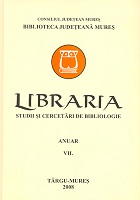Aspecte metodologice privind procesele de catalogare şi descriere bibliografică a documentelor
Some Methodological Aspects Concerning Cataloguing and Bibliographical Description of Documents
Author(s): Adina MureşanSubject(s): Library and Information Science, Cataloguing, Classification, Methodology and research technology
Published by: Biblioteca Județeană Mureș
Keywords: cataloguing; bibliographical description; standards; methodology; documents;
Summary/Abstract: Cataloguing is a specific branch of the bibliographical processing documents, that establishes the rules of creating the necessary instruments for finding the documents in a library collection. The use of collocation „management of organizing library’s collection” is due to the complexity of cataloguing - that refers to following of some rigorous rules and it is based on strictly description rules, established both on national and international level. According to effectual standards, each recording is made of three distinctive elements: 1. the properly bibliographical description - that includes the particular elements of each document; 2. the establishing of those specified elements that will be the main entrances: headings for alphabetic catalogues and classification index; 3. topographic quota, that will indicate the place of documents in library’ depository. Thus, one of the most important jobs a librarian that works on processing documents must do refers to the bibliographical description. We have to clarify a very important aspect from the very beginning: there is no synonymy between the two terms: cataloguing and bibliographical description; it is more like subordinate relation, because each bibliographical description is part of a catalographic registration. Cataloguing registrations are more complex, more extensive as compared bibliographical description and they include some supplementary elements, such as: main and secondary headings, books quota and classification index; each element may be used as a criteria for searching and for the bibliographical card organization. The main headings thus become entrance elements for the systematicalphabetic catalogue and also for the intern catalogue, while classification index is used for an easier searching for books, according to their content. But it is obvious that the use of on-line catalogues makes easier the searching, according to many criteria. Each record of a document contains the following documents: a. heading; b. description; c. access elements; d. codification elements. Cataloguing is only a small part of the process that takes place in a library, more precisely at the cataloguing department. But this domain is so vast, that could hardly be comprised in just one study; in fact, we might consider each stage of the cataloguing process may be the subject for an independent study. Our analysis was not intended to identify each methodological stage of cataloguing; our intention was to present some delicate aspects of this process and we have emphased some of them: • bibliographical description of current monographies; • description in automation system. The examples offered by this study have proved that the management of organizing collections, that also includes cataloguing and bibliographical description, is a complex process that must be treated with responsability, because by a proper administration of the documents recently bought by the library, librarians concure to a higher quality of services.
Journal: Libraria. Studii și cercetări de bibliologie
- Issue Year: VII/2008
- Issue No: 7
- Page Range: 49-61
- Page Count: 13
- Language: Romanian

